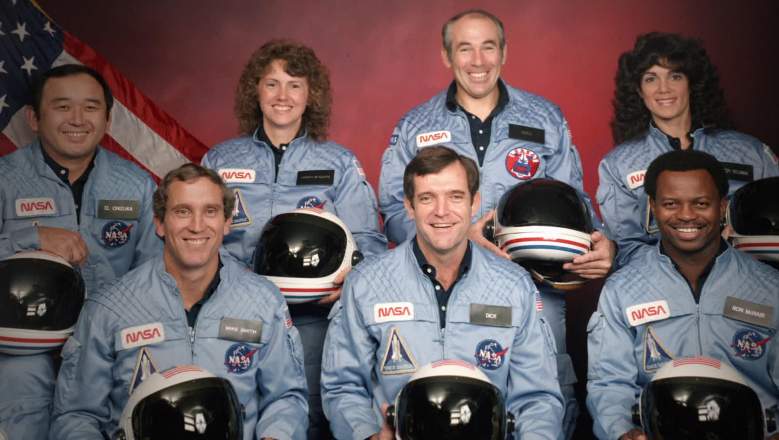
Netflix CHALLENGER - THE FINAL FLIGHT (L to R) The Challenger 7 flight crew: Ellison S. Onizuka; Mike Smith; Christa McAuliffe; Dick Scobee; Gregory Jarvis; Judith Resnik; and Ronald McNair.
The Space Shuttle Challenger disaster is one of those moments that most everyone watching remembers with extreme clarity. The country was glued to the TV to watch seven astronauts, including former social studies teacher Christa McAuliffe, blast off into space. But 73 seconds into the flight, the space shuttle exploded in mid-air and went crashing back to earth, disintegrating over the Atlantic Ocean.
Ahead of the new documentary Challenger: The Final Flight premiering on Netflix, here’s what you need to know about how and why the shuttle exploded and how the astronauts died.
The Astronauts Probably Survived the Explosion
The astronauts were in a reinforced aluminum section of the shuttle and as such, the forces at the time of the explosion “were probably too low to cause death or serious injury to the crew but were sufficient to
separate the crew compartment from the forward fuselage, cargo bay, nose cone, and forward reaction control compartment,” according to a letter about the crash written from Joseph P. Kerwin, the director of Space and Life Sciences at the Johnson Space Center, to NASA’s Associate Administrator for Space Flight Richard H. Truly.
The letter also stated that the crew “possibly, but not certainly, lost consciousness in the seconds following Orbiter breakup due to in-flight loss of crew module pressure.”
After the explosion, the module rose for another 25 seconds due to its upward momentum, then it took 2 minutes, 45 seconds to fall into the ocean. The force of the crash would have far exceeded survivability levels, according to Kerwin. He also reported that they recovered three PEAPs (personal egress air pack), which contained an emergency supply of oxygen, that had been activated, which indicated that at least three crew members were alive and conscious long enough to activate their PEAPs. The PEAPs that were activated belonged to Judith Resnik, mission specialist Ellison Onizuka, and pilot Michael J. Smith.
The investigation concluded that they could not determine whether a lack of oxygen caused any unconsciousness on the part of the astronauts and ultimately they could not determine the precise cause of death.
What Caused the Explosion in the First Place?
The launch was pushed back by almost a week due to adverse weather conditions. But the night before the launch, engineers from Thiokol, the contractor that constructed the shuttle, expressed concern about the low temperatures that night and the morning of the launch, saying the effect of low temperatures on the rubber O-rings that sealed the shuttle’s joints could cause the O-rings to fail, which could cause a catastrophic accident — and that is exactly what ended up happening.
In the 2012 New York Times obituary for Roger Boisjoly, one of the engineers for Thiokol, the Times reported that six months before The Challenger disaster, Boisjoly wrote a memo about this exact problem, saying “the result [of too cold weather] could be a catastrophe of the highest order, loss of human life.”
The Times reported that Boisjoly and his colleagues voiced these concerns the night before the launch, but their bosses, who were under pressure from NASA, rejected the advice. After Boisjoly’s memo was made public, Thiokol cut him off from space work and he was shunned by all of his colleagues. He began suffering from depression and later said the only thing that got him through that time was that Sally Ride, the first American woman to go to space, hugged him after he appeared before the presidential commission that investigated the disaster.
Challenger: The Final Flight is on Netflix now.
READ NEXT: Christa McAuliffe’s Husband and Kids Today